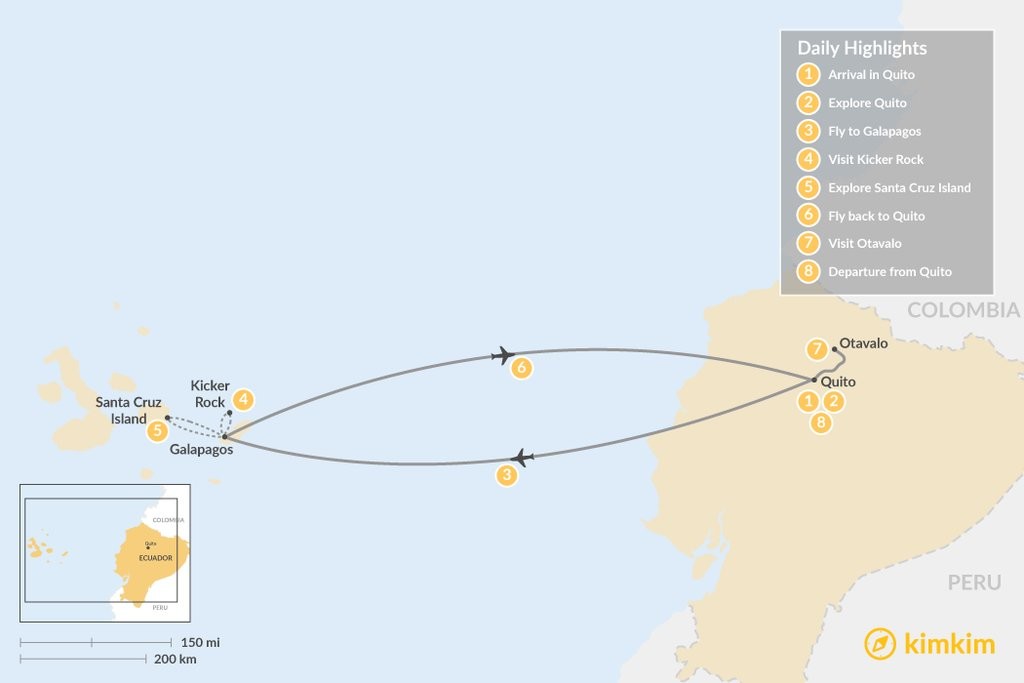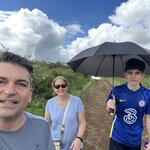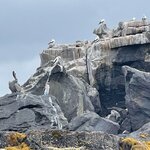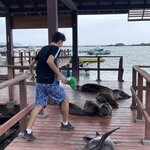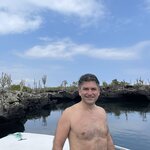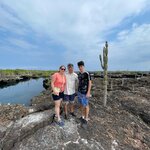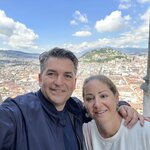Highlights
- Stargaze from the "Middle of the Earth" at an observatory in Quito
- Tour the Otavalo Indigenous market, the biggest market in South America
- Stay on two Galápagos Islands to discover their incredible biodiversity
- See giant tortoises in their natural habitat in the Santa Rosa highlands
Brief Itinerary
| Day | Highlights | Overnight |
|---|---|---|
| Day 1 | Arrive in Quito | Quito |
| Day 2 | Tour of Quito: Cable Cars & Stargazing | Quito |
| Day 3 | Fly to the Galápagos Islands, Discover San Cristóbal | Isla San Cristóbal |
| Day 4 | Boat Trip to Kicker Rock, Transfer to Santa Cruz | Isla Santa Cruz |
| Day 5 | Tour of Santa Cruz Highlands & Tortuga Beach | Isla Santa Cruz |
| Day 6 | Fly to Quito, Tour of Otavalo Indigenous Market | Quito |
| Day 7 | Explore San Pablo Lake & Peguche Waterfall | Quito |
| Day 8 | Depart Quito |
Day 1: Arrive in Quito

Welcome to Quito, the capital of Ecuador. High in the Andes, at an altitude of 9,350 feet (2,850 m), the sprawling city is hugged by the green, steep slope of the Pichincha volcano. Upon arrival, a driver will meet you at the airport and transfer you to your accommodation in the center. While Quito's setting between mountain peaks is impressive, its altitude is only half the story. You'll also find a UNESCO-listed historic center, vibrant nightlife, an impressive culinary scene, grand plazas, shamanic healers, and craftspeople at colorful markets.
You can choose to book an activity today, such as a cooking class or a bike ride. Or, explore at your own pace. Visit the Old Town to discover the colonial churches of San Francisco and La Compañia de Jesús, and orient yourself around the Plaza de la Independencia (also known as Plaza Grande), the city's main square. Climb the hill of El Panecillo to meet the madonna who reigns over the city—the Virgin of El Pacenillo statue. Made of 7,000 pieces of aluminum, the tip of her halo stands at the giddy height of 147 feet (45 m) above ground.
Day 2: Tour of Quito: Cable Cars & Stargazing

A guide will meet you this morning for a full-day tour of Quito's surroundings. Start by heading to the New Town district, to take the TelefériQo cable car up the east side of Pichincha for a view of the cityscape and mountains. It's one of the world's highest-altitude aerial lifts, rising from 10,226 feet (3,117 m) to 12,943 feet (3,945 m).
Back at the base of the cable car, visit the Museo Nacional to get an overview of Ecuadorian history, from the Pre-Columbian civilization through to the colonial era. You'll then move on to the Ethnographical Museum, which showcases Ecuador's Indigenous culture—with a history that stretches back to 10,000 BCE, Quito has one of the richest archaeological heritages in South America.
Beside the museum, you'll have the chance to stand in both hemispheres at once at the Mitad del Mundo (Middle of the World), where the equatorial line is marked on the ground (as approximated by an 18th-century Franco-Spanish mission—the true location lies about 250 yards away). In the early evening, your guide will take you to the oldest observatory in South America, the Astronomical Observatory, founded in 1873. See Ecuador's first telescope, and join a stargazing session from this incredible zero-latitude location.
Day 3: Fly to the Galápagos Islands, Discover San Cristóbal

Welcome to one of the world's great bucket-list destinations, the Galápagos Islands, a volcanic archipelago around 621 miles (1,000 km) off Ecuador's coast. You'll land on Isla San Cristóbal, your base for the night, having flown from Quito. A private driver will meet you at the airport and transfer to your hotel in the island's capital of Puerto Baquerizo Moreno.
After freshening up, head off on a private tour at the Interpretation Center to learn about these islands' explosive beginnings, their discovery in 1535, and humankind's presence here. Next, you'll visit Las Tijeretas Hill, which takes its name from the red-bellied tijeretas (frigatebirds) that inhabit this area. Stop at several viewpoints en route to see if you can spot whales, which pass by between June and October.
Finish the day on the beach of La Lobería, home to a host of iconic Galápagos creatures, such as marine iguanas, blue-footed boobies, and a colony of playful sea lions. There's also the chance to end the day with a snorkeling session if you can't wait to see what's beneath the waves.
Chat with a local specialist who can help organize your trip.
Day 4: Boat Trip to Kicker Rock, Transfer to Santa Cruz

A 50-minute boat ride will whisk you across blue waters to one of the most famous sights in the Galápagos: Kicker Rock or León Dormido (Sleeping Lion). While snorkeling around this dramatic volcanic rock formation, you could encounter sea lions, eagle rays, and turtles, among schools of colorful fish. If you're lucky, you might even spot hammerheads or Galápagos sharks.
After a leisurely lunch onboard, head to one of the area's pristine beaches to relax in the sunshine. You'll then take the public speedboat to Isla Santa Cruz, your base for the next two nights. This is the second largest of the Galápagos Islands and is located in the center of the archipelago. A guide will meet you off the boat and take you to your hotel in Puerto Ayora, a bustling town on the island's southern shore.
Day 5: Tour of Santa Cruz Highlands & Tortuga Beach

This morning you'll come face-to-face with another icon of the Galápagos: giant tortoises roaming around their natural habitat in the highlands of Santa Rosa. This eco-reserve is an hour's drive from Puerto Ayora: here, you'll find verdant pastures, freshwater pools, and scalesia forests. The tortoises favor this landscape during the dry season, when they migrate from the coast.
Another section of the reserve is characterized by lava fields and tunnels, which makes for an otherworldly hike. You'll stop to see the "twin craters" caused by the collapse of empty magma chambers. The forested trail leading to the craters is a great place to spot birdlife, so look out for vermilion flycatchers, Galápagos doves, and several finch species.
Your guide will then bring you back to the coast, where you'll have time to relax on Tortuga Beach. Famed for its soft coral sand stretching over a vast expanse, this is one of the archipelago's most idyllic spots. It's also another chance to watch characterful marine iguanas and sea lions at play. The currents are strong off the main beach, but swimming, snorkeling, and kayaking are allowed in a designated sheltered spot.
Day 6: Fly to Quito, Tour of Otavalo Indigenous Market
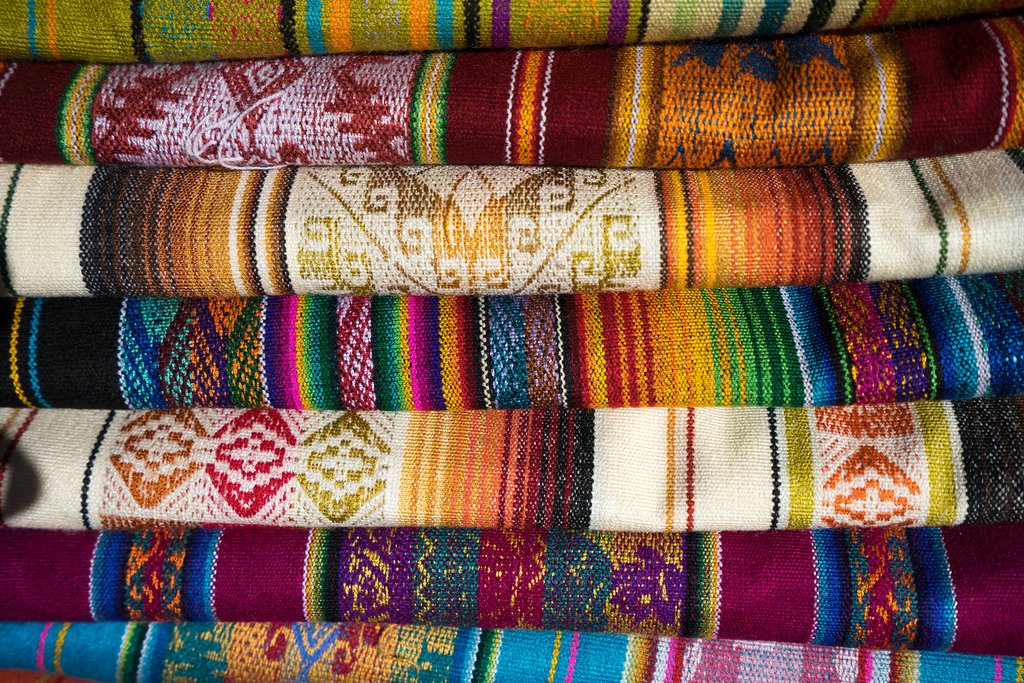
A morning transfer from your hotel in the Galápagos will take you back to the airport for your return flight to Quito. Depending on your schedule, you might have time for an afternoon visit to the Otavalo Market. This is the biggest Indigenous market in South America, where hundreds of people come to buy and sell textiles, art, handpainted crockery, and other traditional goods.
Enjoy some street food (try the salted mango or fritada con mote—fried pork with cooked corn— before swinging by the town of Cotacachi, renowned for its quality leather goods. Then, return to Quito for a free evening. Ask your guide for nightlife tips—as well as salsa clubs, Quito has a thriving craft beer culture, born from ex-pats brewing their own, and it catching on with the locals.
Day 7: Explore San Pablo Lake & Peguche Waterfall

If you didn't have time to visit the Otavalo market yesterday, you could add it to today's itinerary. Otherwise, your guide will take you to Cuicocha, a crater lake formed by an eruption of the Cotacachi volcano. Stroll along the lakeshore trail, or take a boat ride past the two islands formed by lava domes. You'll then have time to relax at the nearby 50-foot (18 m) Peguche Waterfall in Bosque Protector Cascada de Peguche (Peguche Waterfall Protected Forest). Indigenous people bathe in the pools here for purification before important festivals.
In the afternoon, you're in for a sweet treat—a visit to the Bizcocho biscuit factory in the town of Cayambe. These salty, buttery biscuits have their origins in Spain, and they were introduced to the continent when the Spanish settled in the 1500s. You'll see how they're prepared and baked in a wood-fired oven, before sitting down to eat the popular snack like the locals do—dipped in dulce de leche (sweet milk) caramel sauce.
Day 8: Depart Quito

After breakfast, a private driver will pick you up and take you to the airport to catch your flight home. Hasta luego! See you later!
More Great Ecuador Itineraries
Looking for more inspiration for your trip to Ecuador? Check out these other Ecuador itineraries, explore other ways to spend eight days in Ecuador, or discover the best time to visit Ecuador.


